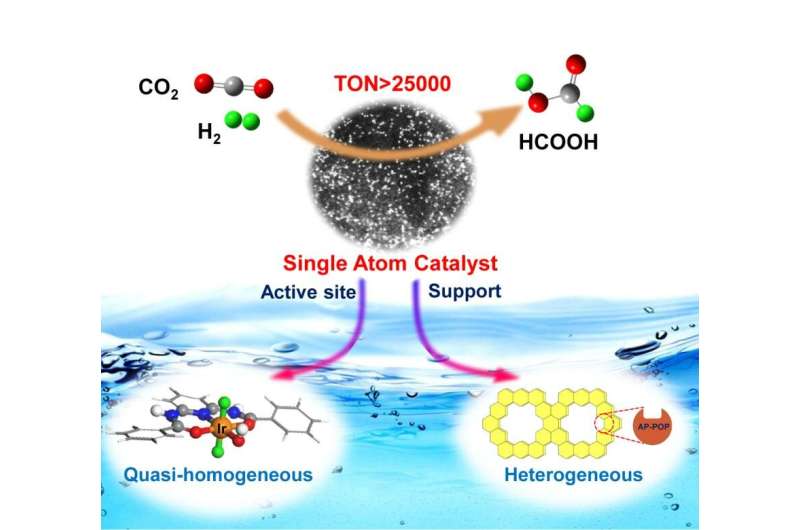Single-atom catalyst based on homogeneous catalysis prototype for CO2 transformation

Single-atom catalysts (SACs) with atomically dispersed active metal centers on supports represent an intermediary between heterogeneous and homogeneous catalysis. Therefore, understanding the homogeneous catalysis prototype creates a great opportunity for designing SACs and developing related applications.
HUANG Yanqiang and colleagues in Prof. Zhang Tao's research group at the Dalian Institute of Chemical Physics (DICP) of the Chinese Academy of Sciences recently developed a strategy for rationally designing a single-atom catalyst. The method involves creating single-atom active sites on supports based on homologous homogeneous prototypes. This process ensures the stability of the active sites and also preserves catalytic capability during the corresponding homogeneous processes.
The strategy is exemplified in the Ir-based catalysts for the catalytic transformation of CO2 to formate. The support in an SAC is similar to the ligands of a mononuclear metal complex in homogeneous catalysis. The surface atomic structure of the support behaves like a "chelator" of organic complexes toward single atom metal centers, and this function is directly related to the chemical bonding and electronic state of the active metal sites.
Accordingly, the design of a support having electron-donating functional groups, which imitates a mononuclear Ir pincer complex, is a key factor in the development of an Ir-based SAC for the catalytic transformation of CO2 to formate.
By developing a porous organic polymer with aminopyridine functionalities to construct Ir single-atom active sites analogous to the mononuclear Ir complexes (Fig. 1), this material exhibits superior activity relative to conventional nanoparticle catalysts during the hydrogenation of CO2 to formate under mild conditions. This represents the best performance yet for a heterogeneous conversion of CO2 to formate, while maintaining outstanding stability upon recycling.
Meanwhile, a catalytic mechanism similar to that over a homogeneous Ir catalyst was observed with this quasi-homogeneous Ir-based SAC. The present strategy provides a promising basis for the design of efficient SACs for use in present-day homogeneous chemical conversions, and serves to illustrate potential bridging between homogeneous and heterogeneous catalysis.
Published in Chem, this work was supported by the National Key R&D Program of China, the Strategic Priority Research Program of the Chinese Academy of Sciences, and the National Natural Science Foundation of China.
More information: Chem (2019). DOI: 10.1016/j.chempr.2018.12.014
Journal information: Chem
Provided by Chinese Academy of Sciences




















